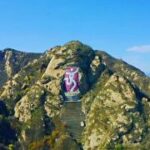The Imperial Academy, also known as ‘Guozijian’, was the highest educational institution and administrative body for education in China during the Ming and Qing dynasties, akin to today’s Ministry of Education. Currently, the Imperial Academy shares a ticketing system with the adjacent Confucius Temple. Visitors purchase tickets to enter the Confucius Temple and then proceed to the Imperial Academy through the ‘Chi Jing Gate’ located next to the Stele Pavilion.
The Imperial Academy features the traditional Chinese architectural layout of ‘facing south and north, with central axis symmetry’. Along the central axis, there are several main structures including the Ji Xian Gate (main entrance), Tai Xue Gate (second entrance), the glazed memorial archway, the Biyong Hall, the Yi Lun Hall, and the Jing Yi Pavilion. Among them, the Biyong Hall is the central building of the Imperial Academy. The Biyong Hall, where emperors used to give lectures, is a unique building located in the center of a circular pond. This architectural form has profound implications: the circular pond surrounding the Biyong Hall symbolizes ‘Yong’ (meaning completeness and perfection), and the circular shape resembles ‘Bi’ (a jade ritual vessel used exclusively by the emperor), signifying the continuous and perfect spread of royal education. Other main structures include the Yi Lun Hall, which was once the site of imperial lectures but later became the library of the Imperial Academy after the construction of the Biyong Hall. North of the Yi Lun Hall is the Jing Yi Pavilion, built in the seventh year of the Jiajing era (1528 AD), which served as the office for the officials of the Imperial Academy. The glazed memorial archway of the Imperial Academy is a unique structure in Beijing that does not belong to a temple. Both the front and back of the archway bear inscriptions written by Emperor Qianlong, reflecting the ancient Chinese emphasis on culture and education. The Imperial Academy also houses several permanent exhibitions such as ‘The Exhibition of Ancient Chinese Imperial Examinations’ and ‘The Exhibition of the Original State of the Imperial Academy’, which are of interest to visitors curious about the imperial examination system. Compared to the bustling scenes at some other Beijing attractions, the Imperial Academy is surrounded by ancient trees and has fewer visitors, creating a very peaceful environment. The surrounding hutong area is also worth exploring, with shaded greenery, courtyard houses with grey walls and blue bricks, and numerous tea houses, stationery shops, and Buddhist item stores along the streets. Opening hours: From 07/23 to 08/31, open Monday, Wednesday-Thursday, Sunday from 09:00 to 17:00; Friday-Saturday from 09:00 to 19:00; closed on Tuesday. From 09/01 to 12/31, open Tuesday-Sunday from 09:00 to 17:00; closed on Monday. On New Year’s Day, Spring Festival, Qingming Festival, Labor Day, Dragon Boat Festival, Mid-Autumn Festival, and National Day, open from 08:30 to 16:30, with indoor exhibition halls closing at 17:00. Special policy notes: 1. Middle and primary school students with valid identification are admitted free of charge, college and vocational students with identification can purchase half-price tickets; retired senior cadres with identification are admitted free of charge; active-duty soldiers with valid identification are admitted free of charge; children under a certain height are admitted free of charge.Children under 2 meters in height enter for free; individuals with disabilities enter for free with a disability certificate; Beijing citizens over the age of 60 enter for free with a senior citizen card. The above information is for reference only; specific details should be confirmed with the attraction on the day of visit. Service Facilities – Restrooms: The attraction has restrooms located near facilities such as the Shengyuan Hall, with clear signs for easy identification.









